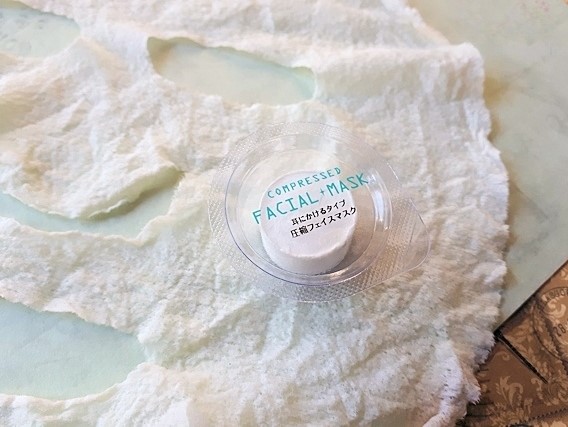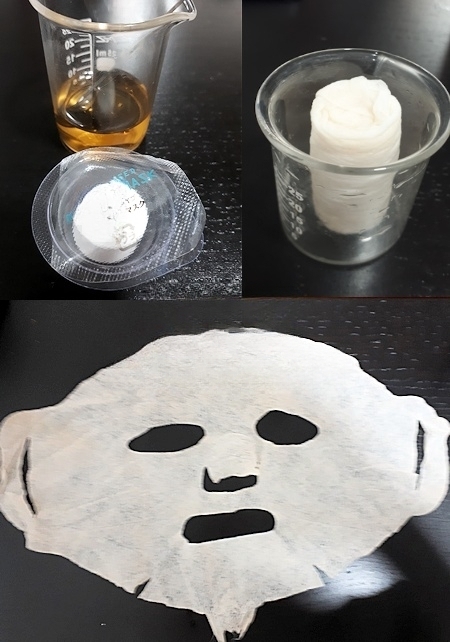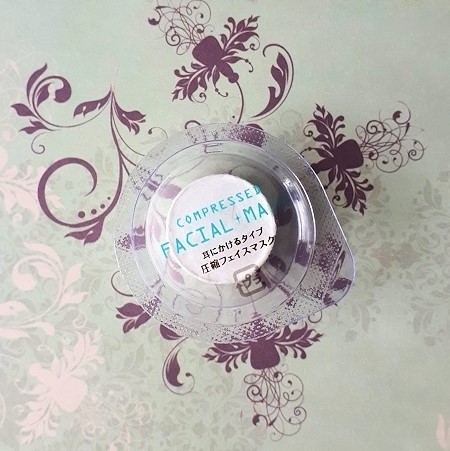How to make a homemade sheet mask using natural ingredients and saving money? It’s very simple! You’ll need compressed facial masks and few ingredients to prepare a solution liquid you could use with.
Sheet masks have become very popular thanks to the Korean and Japanese skincare routines, revolutionizing the world of cosmetic masks.
In this guide I'll answer the most common questions about it and I'll explain you how they work and how to make a homemade sheet mask recipe.
What is a sheet mask?
Sheet masks are cotton sheets soaked in a moisturizing liquid based on water, hydrosols, glycerin, hyaluronic acid, aloe vera and moisturizing water-soluble actives. You can easily reproduce them at home without needing special DIY cosmetics equipment.
Unlike clay-based masks, sheet masks do not dry out and do not need to be rinsed off after use. However, as we will see in the next paragraphs, they can be used with some types of classic masks to enhance their effects.
Commercial sheet masks are usually sold in mono doses packs, already soaked in their liquid. For homemade sheet masks, you need compressed sheet masks to soak in the homemade liquid solution you’ll prepare. The solution can be prepared at the moment or made in big quantities and preserved in a ready to use bottle (in that case you should add a preservative as well, like Isocida).
How do sheet masks work?
The cotton sheet creates an "occlusive" barrier that prevents the product from drying out, warms the skin by opening the pores and allows the active ingredients to penetrate deeper.
This type of treatment maximizes the absorption of the cosmetic by "saturating" the skin and hydrating it thoroughly.
Are homemade sheet masks effective?
Homemade sheet masks are the most effective DIY beauty treatment I have ever seen because you’ll notice the results immediately.
After removing them, your skin will be visibly soft, deeply hydrated and glowing.
How to make a diy sheet mask liquid solution? Where can I find a homemade sheet mask recipe?
You can prepare a liquid solution to use with your compressed sheet masks easily by mixing few simple ingredients.
Hydrosols are the base of DIY sheet mask recipes. You can then add moisturizing actives such as hyaluronic acid, Sodium PCA, aloe vera, plant extracts and other actives. However, the dosage should be lower than the classic recommended one to avoid irritation. Why? This type of mask enhances the effects of the actives and smaller amounts are sufficient.
You can use herbal infusions as well (as long as you use them right away, otherwise they will deteriorate and oxidize even if you add the preservative) and add a very small amount of honey (just a little bit or it will get sticky) or royal jelly.
Considering that you’ll need around 15 g of liquid, this is a basic formula you can follow:
- 13 g of rose hydrosol (or 10 g of chamomile tea)
- 1 g of glycerin (or 1 g of honey)
- 2 g of hyaluronic acid gel
- 3-4 drops of plant extracts (like calendula or mallow extract)
Click here for a ready to use sheet mask liquid recipe with hyaluronic acid.
How to use a homemade sheet mask?
To use a homemade compressed sheet mask you should follow these steps:
- Clean your skin thoroughly and scrub it.
- Put the compressed mask in a small container and soak it with your handmade sheet mask liquid solution (you will need about 12-15 ml of product) until you notice that the mask no longer accepts any more liquid. The mask will hydrate and you’ll be able to easily open and unroll it.
- Apply the liquid-soaked mask to your face.
- Leave it on for 10-15 minutes.
- Remove the homemade sheet mask and apply two or three drops of vegetable oil (jojoba, rice bran or an homemade oil essence like this one) to further soften and "seal" the moisture inside our skin. Massage thoroughly. DO NOT rinse.
- Apply a moisturizer. As Saeki Chizu explains in her famous book The Japanese Skincare Revolution, this step is critically important to "seal" the actives absorbed by our skin.
Can I leave the homemade sheet masks on for more than 15 minutes or overnight?
NO! These sheet masks should not be left on your face for more than 10-15 minutes, otherwise you’ll get the opposite effect. In fact, after this time period has passed, the sheet begins to dry out and to remove moisture from the skin, drying it out (this recommendation also comes from the famous Japanese beauty guru Saeki Chizu of the book I mentioned above).
If you notice that the sheet mask is starting to dry out before the 10 minutes, remove it immediately. For maximum benefits, you should remove it while it is still liquid soaked.
To avoid wasting the precious liquid solution, you can wipe the cotton sheet over your neck and the rest of your body before throwing it away.
Why I should not rinse my face after using a homemade sheet mask?
If we rinse your face afterwards, you’ll remove some of the valuable actives absorbed by our skin during the application time, reducing the beneficial effects of the treatment. Sheet masks are formulated to thoroughly moisturize and have nothing to do with classic clay masks. They leave no sticky residue as it happens when you apply classic DIY masks with clay, yogurt honey and so on.
Different kinds of sheet face masks
On the market you can find different kinds of sheet masks:
- The commercial ones are already soaked with the liquid solution and are sold in disposable single-dose packages. You should use them immediately after opening. They are quite expensive and cost around 2-5 dollars each.
- Empty sheet masks, to be soaked with a liquid solution. They are sold in packs of 20, 30, 50 or 100 pieces and can be compressed or uncompressed. I prefer the compressed ones because they are more hygienic, practical and they do not require much space when stored. To open and use them just soak them in the solution liquid: they’ll absorb it and will be ready to be opened in a few seconds.
Where to buy compressed sheet masks? Are they available on Amazon?
Finding compressed in physical stores is not easy, but you can buy them online.
Yes, Amazon sells them. Make sure to buy the compressed ones, not the ones that are open already.
Can I make a homemade version of sheet masks using cotton, tissues or kitchen paper?
The compressed sheet masks are very practical, hygienic and inexpensive. However, if you do not have this item at home and still want to try this type of mask, you can use cotton makeup remover rectangles, leaving a space for the eyes, nose and mouth. Classic cotton pads can be useful for this purpose, although they are less practical and you will need several of them.
Avoid kitchen paper and the like as they may contain dyes, bleaches and unhealthy chemicals and are not suitable for this kind of mask.
Can I use compressed face masks with traditional mask recipes?
Sheet masks were designed to be used with moisturizing lotions, but if you apply them over rinse-off masks that do not dry out the skin, such as those made with vegetable pulp, yogurt and honey, the occlusive power of the fabric mask will enhance their effects and limit drying.
How often can I use homemade sheet masks?
1 or 2 times a week is enough, but nothing prevents you from using them every day as well (in this case, however, avoid exfoliating beforehand every time). My advice is to apply them at least twice a week or as often as you need extra hydration.
Are sheet masks good for acne for acne-prone skin?
Sheet masks do not get along very well with acne prone skin because their occlusive action and related heat can enhance bacteria proliferation.
If you only have few pimples from time to time and don’t have a sever acne issue, you can use sheet masks without any issue and enjoy its amazing hydrating benefits. A good idea would be adding some purifying active ingredients to make the homemade sheet mask for suitable for you.

